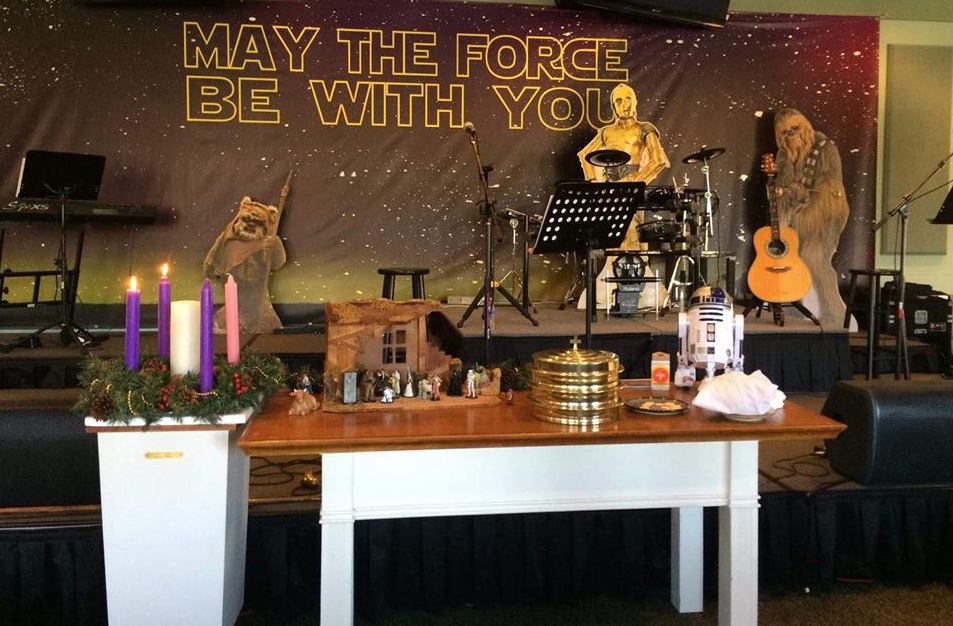For our church, Advent was going to be a little different this year.
While church people have been preparing themselves for the coming of Christ throughout the season of Advent, the reality is that there is another group of people who have been preparing themselves for the coming of something else this December—The Force Awakens.
It’s a story that continues the Star Wars saga, a story of the battle between good and evil, a story of the rise of a redeemer and the Force that empowers him from within. It’s a story that most of our culture knows and connects with.
And it also is a means of connecting them with the story of Christmas.
Sharing Christmas with those who Don’t Know the Story
One Monday in October, our staff team began brainstorming ways we would share the story of Christmas this year, but do so in a way that would connect with people who had no church background or knowledge of the meaning of the Nativity. We knew that for many folks in our area, Christmas was solely about Santa and the gifts you needed to buy in Target. When we began discussing how crazy it was that I had already reserved my tickets for December 17th—the day The Force Awakens would come out in theaters—we started thinking about how we could tell the story of Mary and Joseph and the birth of our Savior through the lens of Star Wars.
The idea involved relating the Force to the Holy Spirit and the coming of Christ as a means of overcoming the Dark Side. It also involved making the worship center into a starry space—literally. On Sunday morning, it was common to see phones out, snapping pictures to send to friends and post on social media. We desired to set the stage with the story people already knew so we could share the story that God wanted them to know.
It was the same message, the same story, but told in an illustration the culture could understand.
Irreverent, Sacrilegious or Contextual?
But some folks did not find our theme to be acceptable. Talking about the connections between the Force and the Holy Spirit, and laughing about Chewbacca in our Nativity was irreverent, even sacrilegious. That’s what set off the negative reactions of a few seminary professors, members of other churches, and pastors who either saw photos of our worship space or engaged in conversation with some of our people. Some of them said we were pandering to the culture, supporting the commercialization of Christmas, taking away the real reason for the season, or turning church into an entertaining circus. Some pastors folded their arms and said they would choose to refrain from even mentioning the new Star Wars movie to their congregation, not wanting to give it any recognition at all.
But in our case, people followed Star Wars to find Jesus. And that was ok with us.
Many of these people have no plan to show up in church at all this December, although they made plans back in October for which movie showing they were going to go to. A number of these folks have no church memory and have received their knowledge of Christianity from the news and their awareness of the Christmas story from Charlie Brown and lawn ornaments. They will never come to a Christmas Cantata, even if it’s advertised, and they have no clue what an Advent wreath is, let alone what color candles belong in it. It’s difficult to even teach folks the meanings of our churchy traditions because we’ve floated further and further away from their realities. Even at Christmas, church is a land that is far, far away, as inaccessible and weird as a far off galaxy.
Even at Christmas, church is a land far, far away, as inaccessible & weird as a far off galaxy.
Tweet this.
That’s why Star Wars isn’t a force to be feared but rather a language to leverage.
The Stories of our Culture
The use of cultural stories and illustrations to connect the people of a culture to a vision of who God is and who Jesus is isn’t a new thing, after all. Jesus himself used them—wandering sheep, sons gone out of control, mean judges, housecleaners, seeds, big fat Jewish weddings—the works. Not all the stories were used to draw parallels to God; in fact, some were used to contrast with God.
The story of Star Wars is no different: while Luke is seen as the messianic figure of the story, he is still only a man; While the Force demonstrates a Holy-Spirit-like power that connects us, empowers us, and speaks to us, it is still impersonal and not available to everyone; while the Dark Side is an evil that can be chosen, its root lies in fear. Star Wars is a fictional story we hear; the story of Christmas is a true story we continue.
Star Wars isn’t a force to be feared but rather a language to leverage.
Tweet this.
Listening to and engaging the culture enabled the early Church to spread the good news of Jesus. In Acts 17, instead of staying in the synagogue with the religious people or putting up a protest against the cultural mindset, Paul chose to go out of his way to encounter the story of the culture in Athens—a culture that blatantly violates the first and second commandments. Paul didn’t turn his back on these people but rather met them where they were; he was invited to share his story in the Areopagus because he spoke in a cultural language they could understand.
Instead of using the genealogy of Jesus or Jewish history—two stories these pagan people did not know– Paul connected to the story they do know: “People of Athens! I see that in every way you are very religious. For as I walked around and looked carefully at your objects of worship, I even found an altar with this inscription: to an unknown god. So you are ignorant of the very thing you worship—and this is what I am going to proclaim to you.” (17:22-23) Luke tells us the result– that while some people laughed at him, “some of the people became followers of Paul and believed.” (17:34)
Historically, the greatest evangelists met people where they were and engaged the stories of their cultural context. Charles Wesley adapted familiar bar tunes to write hymns; Spurgeon acted out stories in his preaching and published his sermons in newspapers; frontier evangelists held camp meetings; Sunday Schools were started to teach children to read. Groups of people who were distant from the world of church were met with bridges that made the gospel accessible and relevant in their lives. Reverent church traditions were not a one-and-done means of understanding the point of Jesus.
The greatest evangelists met people where they were & engaged the stories of their culture.
Tweet this.
Pastor and author Craig Groeschel once said “We will do anything short of sin to reach people who don’t know Christ” and I couldn’t agree with him more. Star Wars is not sin but opportunity. It’s an opportunity to connect the greatest story in history to a popular story people know, a show adults will dress up for, characters that non-church folks are excited about. Stories in our culture can be connecting points that build bridges between what people already know and knowing they can have a relationship with God—the God who came to this earth as a baby in a manger.
After all, the magi followed a star that led them to Jesus. Why not Star Wars?
The magi followed a star that led them to Jesus. Why not Star Wars?
Tweet this.


